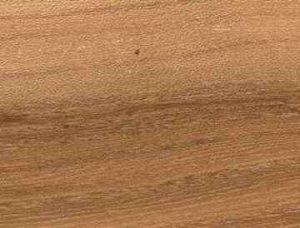Scientific Name
Ulmus hollandica
Trade Name
Dutch elm
Family Name

Common Names
Cork bark elm, Dutch elm, Iep, Orme, Ulme
Regions of Distribution
Eastern Europe, Western Europe
Countries of Distribution [VIEW MAP]
Denmark, France, Germany, Netherlands, Norway, Poland, Russia, United Kingdom
Common Uses
Bent Parts, Boat building, Cabinetmaking, Caskets, Chairs, Decorative veneer, Dockwork, Domestic flooring, Flooring, Furniture , Furniture components, Harbor work, Turnery, Veneer
Environmental Profile
| Status has not been officially assessed |
Distribution Overview
The species occurs on the European continent and throughout Great Britain, and is commonly found in hedgerows, and seldom in forests.
Heartwood Color
| Red | ||||||||||||
| Yellow | ||||||||||||
| Green/grey | ||||||||||||
| Brown | ||||||||||||
| Pink | ||||||||||||
| Orange | ||||||||||||
| Brown |
Dull in color
Sapwood Color
| White | ||||||||||||
| Yellow |
Grain
| Even | ||||||||||||
| Figure | ||||||||||||
| Crossed |
| Even | ||||||||||||
| Crossed |
Large early wood pores produce distinct annual rings, which yield an attractive figure on plain sawn surfaces
Texture
| Medium | ||||||||||||
| Coarse | ||||||||||||
| Coarse |
Luster
| Medium |
Natural Growth Defects
| Center is often defective |
Natural Durability
| Non-durable | ||||||||||||
| Perishable | ||||||||||||
| Very little natural resistance | ||||||||||||
| Sapwood susceptible to attack by powder post beetles |
Dutch elm timber in old structures in England and Wales are susceptible to the death-watch beetle. Logs may be attacked by the forest longhorn
Odor
| No specific smell or taste |
Kiln Schedules
| Schedule A: United Kingdom |
Drying Defects
| Slight checking and cracking | ||||||||||||
| Expect splits | ||||||||||||
| Distortion (twist/warp) is likely | ||||||||||||
| Checking |
Closely space�d stickering and heavily weighted down stacks Degree of degrade can be reduced by reconditioning
Ease of Drying
| Fairly Easy | ||||||||||||
| Moderately Difficult to Difficult | ||||||||||||
| Radial and tangential shrinkage from 4-7% | ||||||||||||
| Dries at a fairly rapid rate |
Tree Size
| Trunk diameter is 100-150 cm | ||||||||||||
| Bole length is 10-20 m | ||||||||||||
| Tree height is 30-40 m | ||||||||||||
| Tree height is 20-30 m | ||||||||||||
| Bole length is 0-10 m | ||||||||||||
| Bark width is 5-10 mm |
Product Sources
Supplies of Dutch elm are limited sometimes because of the reduction in numbers caused by Dutch elm disease.
Blunting Effect
| Moderate effect |
Cutting Resistance
| Easy to saw | ||||||||||||
| Tends to bind on saws | ||||||||||||
| Irregular grain may be difficult to convert |
Gluing
| Good properties |
Moulding
| Requires very sharp cutting edges | ||||||||||||
| Butt end of logs may have irregular grain |
Movement in Service
| Moderate dimensional stability after seasoning | ||||||||||||
| Medium |
Nailing
| Resists splitting |
Planing
| Requires sharp cutting edges | ||||||||||||
| Difficult due to irregular grain |
Wild grain may cause surface tearing during planing
Resistance to Impregnation
| Resistant heartwood | ||||||||||||
| Resistant sapwood | ||||||||||||
| Sapwood is treatable | ||||||||||||
| Heartwood is moderately resistant |
Response to Hand Tools
| Easy to Work | ||||||||||||
| Moderate blunting effect on cutting edges | ||||||||||||
| Difficult to machine |
Screwing
| Good screwing properties |
Veneering Qualities
Some Dutch elm timbers are sliced into veneers for decorative applications
Steam Bending
| Wild grain has little effect | ||||||||||||
| Degrade by splitting may be caused by knots on the inner surfaces | ||||||||||||
| Defect-Free timber responds best |
Polishing
| Wax finish | ||||||||||||
| Very good results |
Staining
| Stains well |
Strength Properties
| Crushing strength = low | ||||||||||||
| Bending strength (MOR) = low |
Straight grain
Numerical Data
| Item | Green | Dry | English |
| Bending Strength | 5958 | 9962 | psi |
| Density | 33 | lbs/ft3 | |
| Hardness | 853 | lbs | |
| Impact Strength | 31 | 27 | inches |
| Maximum Crushing Strength | 2550 | 4638 | psi |
| Shearing Strength | 1656 | psi | |
| Stiffness | 818 | 1091 | 1000 psi |
| Work to Maximum Load | 10 | 11 | inch-lbs/in3 |
| Specific Gravity | 0.53 | ||
| Weight | 37 | 30 | lbs/ft3 |
| Item | Green | Dry | Metric |
| Bending Strength | 418 | 700 | kg/cm2 |
| Density | 528 | kg/m3 | |
| Hardness | 386 | kg | |
| Impact Strength | 78 | 68 | cm |
| Maximum Crushing Strength | 179 | 326 | kg/cm2 |
| Shearing Strength | 116 | kg/cm2 | |
| Stiffness | 57 | 76 | 1000 kg/cm2 |
| Work to Maximum Load | 0.70 | 0.77 | cm-kg/cm3 |
| Specific Gravity | 0.53 |
References
HMSO. 1981. Handbook of Hardwoods, 2nd Edition. Revised by R.H. Farmer. Department of the Environment, Building Research Establishment, Princes Risborough Laboratory, Princes Risborough, Aylesbury, Buckinghamshire.
Jackson, A. and D. Day. 1992. Good Wood Handbook – The Wood worker’s Guide to Identifying, Selecting and Using the Right Wood. HarperCollins Publishers, London.
Lavers, G.M. 1967. The Strength Properties of Timbers. Forest Products Research Bulletin, No. 50 (Spersedes Bulletin No. 45). Ministry of Technology, Her Majesty’s Stationery Office, London.
Lincoln, W.A. 1986. World Woods in Color. Linden Publishing Co. Inc. Fresno, California.